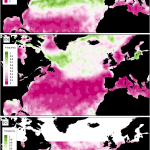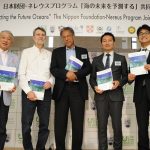By Rebecca Asch, Senior Nereus Fellow, Princeton University
The Ocean Carbon and Biogeochemistry (OCB) Summer Workshop is an annual event where scientists leading research on the carbon cycle and circulation of nutrients in the ocean meet to discuss advances in their field and jointly plan new research initiatives. This year it was held from July 25 to 28 at the Woods Hole Oceanographic Institution in Massachusetts, USA.
The reason why I, as a fisheries oceanographer, attended and presented at a conference on ocean biogeochemistry is two-fold:
(1) Climate tends to influence fisheries through what are known as “bottom-up” processes. In other words, changes in climate conditions, such as temperature, precipitation, and winds, affect ocean mixing and circulation, which in turn affect the availability of light and nutrients for plankton in the ocean. Increases in light and/or nutrients can fuel increased production by plankton at the base of the ocean food web. This, in turn, can affect the production of fishes. It is important for fisheries oceanographers to understand the nutrient cycle in the ocean since this will affect the ocean’s carrying capacity, which determines how many fishes are available to fisheries.
(2) Most projections of how climate change will affect fisheries in the future are driven by models of these “bottom up” processes. As a result, it is important for fisheries oceanographers to understand the advances and improvements in biogeochemical modeling efforts since these can influence the accuracy of projections on how fish will respond to climate change. The OCB workshop is a good venue where both modellers and observational oceanographers can meet and discuss their research.

Rebecca Asch touring the R/V Atlantis – one of the research vessels operated by Woods Hole Oceanographic Institution. Credit: Jasmin John, NOAA/GFDL
This year’s OCB meeting was supported by the National Science Foundation (NSF), NASA, and NOAA. NASA presented on two programs, including a prospective new research program to examine how the ocean stores carbon dioxide and a second program that will focus on better understanding climate change impacts in the Arctic Ocean.
Another session looked at the use of new robotic floats to collect data from the Southern Ocean in winter. In the past we knew little about the oceanography and ecology of the Southern Ocean during this season since winter conditions are so harsh that they prohibit oceanographers from going out and collecting samples with boats. A presentation by Nereus Program Principal Investigator at Princeton University Jorge Sarmiento showed that these floats are changing and expanding our understanding of the carbon cycle in the Southern Ocean.
Wednesday’s session was a review of what is known and unknown about the biogeochemistry of the Indian Ocean. Several talks in this session tied into how ocean circulation patterns affect the productivity of fisheries. For example, eddies in the Leeuwin Current affect the dispersal and health of the larvae of Australia’s commercially important rock lobster fishery. Similarly sardines off the east coast of South Africa were hypothesized to take advantage of counter-current flows during their seasonal migration.
On Thursday morning the workshop included a session dedicated to discussing “thresholds” and “regime shifts” in marine ecosystems. This session was probably the most relevant to those of us interested in fisheries production. There were four talks included in this session, including my own.
Philip Boyd, who traveled all the way to the conference from Tasmania, gave the first talk. His talk focused on reviewing recent studies showing that climate change has shifted the distribution of plankton and has shuffled the composition of species in plankton communities. He also talked about the potential roles of adaptation and acclimation in influencing how plankton will respond to climate change.
My own talk focused on my Nereus-sponsored research showing that both phytoplankton and fish are responding to climate change by altering their seasonal behavior and growth patterns. However, these organisms are not changing their seasonality at the same rate. As a result, in many areas of the ocean fish may end up spawning too early – meaning that they may spawn before a sufficiently large crop of plankton has built up to feed the larvae of the fishes.
The third talk in this session was given by Jacqueline Grebmeier from the University of Maryland, who talked about how climate change is altering seafloor ecosystems in the Arctic. Her talk included some very cool videos of sand dollars, sea urchins, fishes, and other organisms residing on the seafloor. Lastly, Mary Hunsicker from NOAA’s Norhwest Fisheries Science Center talked about the tools that ecologists can use to identify when ecosystem regimes shifts have occurred and to potentially forecast regime shifts before they happen. This nascent forecasting ability is important because it could potentially help fisheries and ecosystem managers adapt their management practices to changing conditions.
 REBECCA ASCH, PHD, BIOLOGICAL OCEANOGRAPHY, PRINCETON
REBECCA ASCH, PHD, BIOLOGICAL OCEANOGRAPHY, PRINCETON
Rebecca Asch is a fisheries oceanographer whose research focuses on the interaction between climate and fisheries. As a Senior Nereus Fellow, Asch is using an Earth System Model developed at the NOAA Geophysical Fluid Dynamics Laboratory (GFDL) to examine future changes in the seasonal timing of fish spawning and phytoplankton blooms. This research investigates the hypothesis that climate change could lead to an increased frequency of “mismatches” between these seasonal events. In turn, such mismatches may potentially lead to poor feeding condition for fish larvae, slower growth of young fishes, lower recruitment, and ultimately decreased productivity of fisheries.








